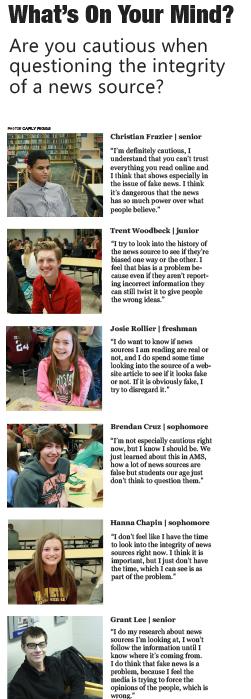Staff Ed: Fake News? News integrity is up to the reader to determine
March 8, 2017
“Fake News.” These words have managed to cement themselves into the minds of news consumers as buzz language that can make readers turn and run in the opposite direction. In light of recent news events, the question of media and news integrity has been brought to the forefront.
Credibility has been questioned, and more often than not, certain sources have revealed that consumers have trusted their minds to the wrong outlets. This can not continue. News outlets should not be the ones claiming to know the inaccuracy of other news outlets, this is the job of the individual consumer.
Trending news stories, both fake and real, buy into what’s called the attention economy, whereby “if people pay attention to a certain topic,  more information on that topic will be produced,” according to PBS Newshour. Tactics like these are the root cause of fake news stories getting so much attention in the media, this is also why fake news stories can make wild accusations without consumers immediately flagging them as fake, because they grab the reader’s attention and keep them interested.
more information on that topic will be produced,” according to PBS Newshour. Tactics like these are the root cause of fake news stories getting so much attention in the media, this is also why fake news stories can make wild accusations without consumers immediately flagging them as fake, because they grab the reader’s attention and keep them interested.
Facebook installed a button in the right corner of posts that allowed readers to flag posts as fake, but then satirical content producers like The Daily Currant protested, based on research to be published by Milan Young in an upcoming book in 2017. Facebook appeared to change how flagged stories were distributed, and referrals from Facebook to The Daily Currant dropped by 95 percent within a few months.
A public poll conducted by Nanos Research and commissioned by Signal Leadership Community found that 59 percent of people are worried about the rise of fake news. However, this same research group also found in a public poll that 66 percent of people couldn’t tell at first glance if a news story was true or false. The fact that consumers are unaccustomed to figuring out the credibility of news stories on their own could possibly be a bigger problem than the idea of fake news. The saying “don’t believe everything you read” has been prevalent for years and yet people still haven’t learned the key factors in pinpointing accuracy.
If it is up to the consumers to distinguish fake news from the truth, these readers must know the key factors in recognizing inaccuracy. The first thing to consider in the question of credibility is the source of the story. Reading beyond the headline is the next thing to consider. Provocative headlines are meant to generate attention, and even with legitimate news outlets, the headline doesn’t always tell the whole story. The most important tell-tale sign to look for is the quality of data used to back-up the article. If the statistics, polls or quotes look phony, the story probably is.
Naivety is no longer an excuse to accept these fake news stories. The only way that these stories will stop is if the consumers are able to be their own watchdog in the question of credibility. Fake outlets won’t keep producing inaccurate information if the public has lost the desire to consume it. Educate yourself about the dangers of accepting fake news and learn the tell-tale signs of fake news, because that is the only way to stop it.









